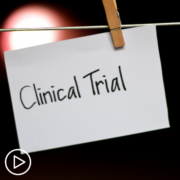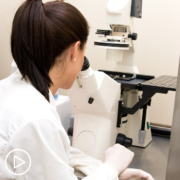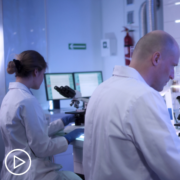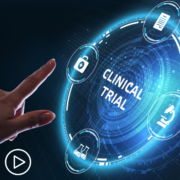Tag Archive for: polycythemia vera
How Is Personalized Medicine in MPN Care Influenced by Telemedicine?
How Is Personalized Medicine in MPN Care Influenced by Telemedicine? from Patient Empowerment Network on Vimeo.
How is MPN personalized medicine impacted by telemedicine? Watch as expert Dr. Jeanne Palmer shares situations where personalized care can aid essential thrombocythemia, myelofibrosis, and polycythemia vera patients, how telemedicine can aid in care, and the value of specialized care.
See More from MPN TelemEDucation
Related Resources:

|

|

|
Transcript:
Dr. Palmer:
So I think one of the key…so when we look at treating different myeloproliferative neoplasms, you have to take what’s your goal of therapy. So for the ones like essential thrombocythemia, where you have too many platelets, or polycythemia vera, where there’s too many red cells. A lot of times what you’re doing there is you’re just saying, “Well, how can I predict whether you’re going to have a blood clot or something?” Because people can live, these can be fairly chronic diseases that with appropriate therapy, people can live a long time.
So a lot of that’s risk mitigation. Where I think a lot of the personalized aspect of it is coming in is probably in myelofibrosis, which is a disease where I view it as too much inflammation, scar tissue develops in the bone marrow, people could get a large spleen, high white blood cell count. A number of different manifestations. And in that, we’re learning more and more that in addition to the three driver mutations, the JAK2, the MPL, and the calreticulin, there’s probably a whole other group of mutations that can really be used to help us predict and try to take a look into the future to help guide them. And what is the timing for transplant? Should we be more aggressive as we’re getting more and more agents being evaluated and hopefully approved in the treatment of myeloproliferative diseases? Who are the people who should utilize these agents?
Because again, you don’t want to overtreat. And so I think that being able to hone in on these different mutations to be able to help us predict what we think will happen and maybe different treatment options that we would have, that’s going to be important. Now, one of the things that’s really exciting is that some of these companies that actually do this deep sequence, like looking at multiple, multiple genes, actually have mechanisms by which they will send somebody to a person’s house and then draw the blood and take it over and run it. And so I’ve actually had that done before, where somebody I saw via telemedicine, and we really wanted to get that information so I could appropriately advise on what I anticipated was going to happen in the course of the disease.
And we were able to actually get that information through using home care, saying, “I want this order to be done. The home care people went out, drew the blood, sent it to where it needed to go in the right format, and I was able to get that information.” So I think that telemedicine allows them access to people who understand how to interpret that information. But I think we have to give a lot of props to a lot of these companies that are really getting innovative in how they’re capturing the data, saying, no, you know what? You don’t need to have this done in Scottsdale, Arizona or Phoenix, Arizona. You can have this done in your own home and wherever your home happens to be.
So I think that that type of thing is really changing some of how we can utilize that data that’s very personalized, but be able to use it in a telemedicine format where we don’t need people to physically come here to get their blood taken. Now, I do want to add the caveat. There are a number of different institutions have enormous amounts of lab work that’s looking at things above and beyond the approved tests that have been validated and everything. And that would be a lot harder to get. There still are ways of doing that, but I think that we have to acknowledge that there is something that we do lose by doing that. Although I can get a lot of information, be able to provide a lot of input to a patient. It still doesn’t address the fact that by physically being there, sometimes you can get samples that you can biobank and you can send to somebody’s lab. And then these are the people who are discovering the new things that really that’s how we learned what we know so far. Is because somebody went and looked at these genes and more and more and more of this is going on. So I want to temper this with saying not everything can be done by a telemedicine.
That we have to be thoughtful about our approaches and really utilize combining in-person visits along with telemedicine to really do care. And to give an example, what I do for patients is if I follow them by a telemedicine only, I won’t actually be a prescribing doctor. I won’t be a primary provider. I have to at least see them once a year if I’m going to give medicines or do things like that. So I think that there’s a hybrid model that’s going to be really important to do as well for patients who are able to do that.
Lisa Hatfield:
Thanks for that.
Dr. Palmer:
If that makes…yeah.
Lisa Hatfield:
It does make sense. And I just had a quick question too. So if I’m coming in or I’m going to see my…I’m a newly diagnosed MPN patient going into my local oncologist. I’m watching this webinar and I hear, “Oh, if somebody came to my home. I could maybe do telemedicine, or I can have somebody come to my home and take my blood and look at these genetic mutations. My local oncologist doesn’t know exactly how to go about doing that.” Would that be the point where they might try to contact a specialist or go through the consult center through Mayo Clinic or somewhere to say, “Oh, I need a specialist to help me access this type of testing?”
Dr. Palmer:
So I have to be very honest. I just learned about this type of testing in the last year or so. And so it’s something that I’ve started to be able to utilize. With myeloproliferative diseases, I think, and very honestly, and there’s a number of us specialists around the country, I think everyone seeing one at least once in terms of just saying, hey, what’s our plan of care going to be? Are we looking at all the angles of it is a really important thing to do. And I think there’s a number of excellent physicians out there in different parts of the country that some of whom are using telemedicine, some I’m not sure that they are. But I think that getting that specialized opinion is extremely important. I think then in terms of managing care, there’s multiple… There’s multiple ways that can be configured that will help take care of the patient depending on their individual needs and their ability to travel and everything.
Share Your Feedback:
What Do MPN Patients Need to Know About Clinical Trials?
What Do MPN Patients Need to Know About Clinical Trials? from Patient Empowerment Network on Vimeo.
What is a clinical trial and how does patient participation work? This animated video provides an overview of clinical trials, the process, and details key steps for engaging in your care.
See More From MPN Clinical Trials 201
Related Programs:

|

|

Clinical Trials As an MPN Treatment Option: What You Should Know |
Transcript:
Brian:
Hi, I’m Brian and this is my doctor, Dr. Liu.
I have myelofibrosis, which is a type of myeloproliferative neoplasm, or MPN as it’s commonly referred to.
And when discussing therapy with my doctor. She suggested a clinical trial might be my best treatment option. Dr. Liu, can you please explain what a clinical trial is?
Dr. Liu:
Absolutely. In basic terms, a clinical trial is a research study that involves human volunteers. The goal of cancer clinical trials is to discover new and improved approaches to prevent or treat the disease.
There are typically four phases of a trial. Each phase gathers valuable information about the treatment and helps measure its effectiveness1.
But, Brian you had some hesitations at first, right?
Brian:
That’s right. Although I trusted your advice, I definitely had questions about the process.
One thing I worried about was safety. I asked Dr. Liu how I would be kept safe if I participated in a clinical trial.
Dr. Liu:
I hear this concern a lot from patients. But every trial has a strict safety protocol, with set guidelines in place to protect patients.
Additionally, researchers must follow patient safety rules, which are regulated by the U.S Food & Drug Administration (the FDA). And an institutional review board (or IRB) regularly reviews a study at each study location. Plus, many trials are overseen by a group called a data and safety monitoring committee2.
Finally, there is also a clinical trial team that can include healthcare team members like cancer researchers and oncology nurses. This team regularly observes the health of each participant, through each stage of the process. Because of this, trials often involve more testing and visits, which can be a bigger commitment for a patient.
Brian:
When Dr. Liu explained the safety measures, it helped me feel more confident in the process and comfortable about participating. So, then I asked which trial she would recommend for my individual disease.
Dr. Liu:
It’s important to note that every trial has “eligibility requirements” that include things like a patient’s age, health, and prior treatments they have received. These requirements determine whether a patient qualifies for a trial.
We talked about which trials may be a good fit for Brian and discussed the pros and cons of each one. We also reviewed the logistical and financial impact the trials could have on his life.
Brian:
That’s right. Dr. Liu also pointed out that patients can leave a trial at any time–for any reason– once they have enrolled.
Dr. Liu:
That’s right—participation is completely voluntary.
Brian:
One of the main reasons that I joined a trial was because I wanted to find out if a treatment in development would be more effective in treating my cancer. AND I wanted to help advance research forward, so I could help the MPN community.
Dr. Liu:
Right, Brian. Patients may have different reasons for participating, but trials are the only way to develop and study new and improved treatments for MPNs.
Now that you understand more about trials, how can you find out more?
- Start by asking your doctor if there are any trials that you are eligible for.
- If there is a trial that your team recommends, ask to discuss:
- The treatment approach used in the study and the purpose of the trial.
- The risks and benefits of participation.
- The financial costs, if any, and if there are assistance programs to help if you need it.
- The location of the trial and whether it can be coordinated with your local institution if it isn’t conveniently located—or if transportation is available.
- And, how often you will need to visit the trial site and how long the trial will last.
- Finally, continue to educate yourself, using resources like clinicaltrials.gov.
Brian:
We hope you found this information useful! Visit powerfulpatients.org/MPN to learn more about clinical trials and MPN research.
Dr. Liu:
Thanks for joining us!
Should All MPN Patients Undergo Molecular Testing?
Should All MPN Patients Undergo Molecular Testing? from Patient Empowerment Network on Vimeo.
Dr. Gabriela Hobbs discusses the necessity of molecular testing for myeloproliferative neoplasm (MPN) patients, including the pros and cons of this in-depth testing for patients with polycythemia vera (PV) and essential thrombocythemia (ET).
Dr. Gabriela Hobbs is a hematology-oncology physician specializing in the care of patients with myeloproliferative neoplasms (MPN), chronic myeloid leukemia, and leukemia. Dr. Hobbs serves as clinical director of the adult leukemia service at Massachusetts General Hospital. Learn more about Dr. Hobbs.
See More From MPN Clinical Trials 201
Related Programs:

|

|

|
Transcript:
Katherine:
How useful is having a genetic panel done? Should all patients get molecular or genetic testing?
Dr. Hobbs:
Great question. And I think that it is very important to have genetic testing.
And genetic testing involves more than just testing the JAK2 mutation. So, we know that the JAK2 mutation is the most common mutation in patients with MPN. But that being said, there are other mutations that also occur such as the calreticulin mutation and the MPL mutation.
And so, I think having genetic testing that at least tests for those three mutations is very important so that we can actually help a patient know that they have an MPN. In addition to those three main mutations, many clinicians now have access to what’s called extended next-generation sequencing, where there’s a panel that tests for many different genes at the same time and can test for a variety of other mutations.
And this is particularly relevant for patients with myelofibrosis. As we know that having other mutations, like, for example, mutations in IDH or ASXL1 and others, can increase the risk of that disease in terms of its risk of transforming to leukemia or how long a patient may live with their myelofibrosis.
And so, I do recommend having extended next-generation sequencing done at least at diagnosis.
When I generally think about repeating that, if there’s something that looks like it’s changing within the patient’s disease, to be honest, also on the flipside of that argument, sometimes this next-generation sequencing will mostly contribute to adding anxiety and will not necessarily directly impact how a patient is treated. And this is particularly true in patients with PV and ET, where we’ll sometimes order these tests, and we get a bunch of mutations back, but we don’t know what to do with that information yet.
And so, as a researcher – not a clinician – as a researcher, I think it’s very important to have that information so that we can then do studies and understand the patterns of mutations and how that affects outcome. But as a clinician, and you as a patient, you need to really be aware of how that’s going to impact the patient in front of you and how that may impact you as a patient. Do you want to know if you have these mutations if nothing can be done about it? So, I would say, take a moment to reflect upon what I said and also to ask your clinician, how is this information going to help me? Do I need to have this information?
Maybe you want to have it done so that it’s in your record. But maybe you don’t necessarily want to know those results. And everybody’s very different. And I think it’s absolutely wonderful to talk to my patients about all the information. But there may be some patients that really are just, like, do the test but don’t tell me the results, because I know that I’m just going to be very anxious knowing that I have something that I can’t do anything about. So, just take a minute to talk about it with your doctors. I think that’s really important.
What Are the Long-Term Effects of JAK Inhibitors?
What Are the Long-Term Effects of JAK Inhibitors? from Patient Empowerment Network on Vimeo.
MPN expert Dr. Gabriela Hobbs discusses what researchers know about the long-term safety of JAK inhibitors and options for patients if the treatment loses effectiveness over time.
Dr. Gabriela Hobbs is a hematology-oncology physician specializing in the care of patients with myeloproliferative neoplasms (MPN), chronic myeloid leukemia, and leukemia. Dr. Hobbs serves as clinical director of the adult leukemia service at Massachusetts General Hospital. Learn more about Dr. Hobbs.
See More From MPN Clinical Trials 201
Related Programs:

|

|

|
Transcript:
Katherine:
What are the long-term effects of JAK inhibitors? And what happens when JAK inhibitors are no longer effective?
Dr. Hobbs:
Yeah. Great question. So, so far the patients that have been on JAK inhibitors for a long time don’t seem to have the development of additional toxicities that we didn’t know about.
So, I’ll just comment on some of the things that we do know about. Weight gain is a common complaint that I have from patients, especially those that have polycythemia vera, because maybe they didn’t want to gain weight when they were put on a JAK inhibitor compared to the myelofibrosis patients who maybe had lost a lot of weight before being on a JAK inhibitor.
There are certainly higher risk probably of developing infections with some of the JAK inhibitors. And we see, for example, shingles reactivation being a common one. And there’s the concern of development of skin cancers, which has been seen with some JAK inhibitors. But generally speaking, long-term use seems to be safe. That being said, ruxolitinib (Jakafi), which is the oldest one to be approved, has only been around since 2011, so we don’t have decades worth of experience to know.
When JAK inhibitors stop working – to answer the second part of your question – until fairly recently we really didn’t have a whole lot to offer because there was only one JAK inhibitor. Now we have two others. We have fedratinib (Inrebic) and also pacritinib (Vonjo). And we know from the studies that have been done with both of these agents that some patients that lose response to Jakafi, meaning that their spleen starts to grow or their symptoms start to come back, can be treated with these other JAK inhibitors.
And many patients will, again, have control of their spleen and symptoms. Now losing response to a JAK inhibitor can come in many different ways. And so, some patients may also develop signs of having leukemia or progression of their disease to leukemia. And, unfortunately, for those patients, being on another JAK inhibitor doesn’t make sense. So, those patients may need to receive other types of medications or a stem cell transplant.
Advances in Myelofibrosis Research
Advances in Myelofibrosis Research from Patient Empowerment Network on Vimeo.
What are the recent developments in the study and advancement of myelofibrosis treatment? MPN researcher Dr. Gabriela Hobbs discusses ongoing clinical trials for new JAK inhibitors, BET inhibitors, and anemia therapies, among others.
Dr. Gabriela Hobbs is a hematology-oncology physician specializing in the care of patients with myeloproliferative neoplasms (MPN), chronic myeloid leukemia, and leukemia. Dr. Hobbs serves as clinical director of the adult leukemia service at Massachusetts General Hospital. Learn more about Dr. Hobbs.
See More From MPN Clinical Trials 201
Related Programs:

|

|

|
Transcript:
Katherine:
What about myelofibrosis, Dr. Hobbs? What advances are being made in the care of patients with this more advanced MPN?
Dr. Hobbs:
Yeah. So, in myelofibrosis, I would say it is almost difficult to keep track of how many clinical trials are currently open. So, in 2011, we had ruxolitinib approved, or Jakafi. That was the first JAK inhibitor. Since then, we’ve had two more JAK inhibitors approved, fedratinib (Inrebic) and most recently pacritinib (Vonjo). And we’re currently awaiting the fourth JAK inhibitor to be approved, and that’s called momelotinib.
And in addition to the JAK inhibitors, there are lots of other clinical trials underway right now that are either alone – a drug by itself or a drug in combination with ruxolitinib.
So, there are several Phase III studies. And the reason why that’s important is that after Phase III we usually see a drug approval. So, we can expect, hopefully in the next couple of years, to see many more drugs available on the market to treat patients with myelofibrosis. Some of those include agents that block different pathways within a cell. And that includes a drug called parsaclisib. There’s a drug called pelabresib (CPI-0610), which is a BET inhibitor.
There’s another drug called navitoclax (ABT-263), which is a cousin of venetoclax (Venclexta), which is a drug that we’ve been using a lot in leukemia. So, there’s lots of different drugs that are being used in combination with ruxolitinib. There’s also a drug called luspatercept (Reblozyl) that’s also been approved for myelodysplastic syndromes. And I suspect that that’ll be approved as well to help patients with anemia. So, really, there’s lots of drugs that are being studied right now. And I think the question that we’re all asking is, well, how are we going to use all of these different drugs? So, I look forward to seeing the results of those studies.
Katherine:
Mm-hmm. Will some drugs work better for some patients and others not?
Dr. Hobbs:
That is such a good question. And so, what I’m hoping to see is exactly that. I’m hoping to see that for patients, for example, with anemia, perhaps we’re going to be using luspatercept and momelotinib. Perhaps we’re going to see that patients with certain mutations may respond better to certain medications like the BET inhibitors or navitoclax or the PI3 kinase inhibitor, parsaclisib. But as of now, we don’t have enough information.
We haven’t seen enough results of these studies to start to be able to know, you know, what is the patient that’s going to do better with two drugs versus one drug? And so, I think that over the next couple of years we’re going to start to have answers to those questions.
Advances in Polycythemia Vera Research
Advances in Polycythemia Vera Research from Patient Empowerment Network on Vimeo.
What are the recent developments in the study and advancement of care for patients with polycythemia vera (PV)? Dr. Gabriela Hobbs reviews recently approved PV treatments as well as those currently in clinical trials.
Dr. Gabriela Hobbs is a hematology-oncology physician specializing in the care of patients with myeloproliferative neoplasms (MPN), chronic myeloid leukemia, and leukemia. Dr. Hobbs serves as clinical director of the adult leukemia service at Massachusetts General Hospital. Learn more about Dr. Hobbs.
See More From MPN Clinical Trials 201
Related Programs:

|

The Risks and Benefits of Participating in an MPN Clinical Trial |

|
Transcript:
Katherine:
There was recently an interferon approved for use in patients with PV. What other studies are showing promise for patients with PV?
Dr. Hobbs:
Yeah. So, we as a community, there’s been a lot of excitement about this new interferon that was approved, the ropeginterferon (Besremi) study. And there are still some ongoing studies utilizing ropeginterferon to see if we can use it differently.
Because currently the way that that drug is approved is that it has to be titrated up very slowly to get to the maximum dose. So, that’s something that is still ongoing. In addition, there’s a new drug that’s being studied called Rusfertide (PTG-300) from a company called Protagonist. And this drug has been very interesting. It acts through iron metabolism.
And so far in preliminary results, it has shown that a lot of the participants that receive this medication no longer need phlebotomy. And I think what’s exciting about this is that phlebotomy is a very archaic way of treating patients.
And I hope that we can stop utilizing it. So, it’s nice to have a compound that’s specifically asking that question. And the other thing to keep in mind is that this drug has been used in combination with other drugs, which is really reflective of how participants or patients show up to clinics.
Some patients are not going to be on any medications. Some patients may be on hydroxyurea (Hydrea).
Some patients may be on an interferon. Some patients may be on ruxolitinib (Jakafi). And these trials allow participants to be on a variety of different medications. So, that’s an exciting new compound.
Advances in Essential Thrombocythemia Research
Advances in Essential Thrombocythemia Research from Patient Empowerment Network on Vimeo.
Are there new treatment developments for patients with essential thrombocythemia (ET)? Dr. Gabriela Hobbs shares an update on ET therapies in clinical trials and discusses when it might be appropriate for a patient to join a clinical trial.
Dr. Gabriela Hobbs is a hematology-oncology physician specializing in the care of patients with myeloproliferative neoplasms (MPN), chronic myeloid leukemia, and leukemia. Dr. Hobbs serves as clinical director of the adult leukemia service at Massachusetts General Hospital. Learn more about Dr. Hobbs.
See More From MPN Clinical Trials 201
Related Programs:

|

The Risks and Benefits of Participating in an MPN Clinical Trial |

|
Transcript:
Katherine:
Let’s talk about ET for a moment. Is there any research being done to help better manage this condition?
Dr. Hobbs:
Yeah. I would say that of the three MPNs, ET is certainly the one that has the least amount of drugs that are being currently studied for this group. But that doesn’t mean that there isn’t any research. Ropeginterferon (Besremi), which was recently approved in polycythemia vera, is now being studied in essential thrombocythemia.
So, I would expect in the next couple of years, if those trials are successful, to have ropeginterferon as a therapy to offer patients.
There is also a clinical trial that we have at our site. We’re using ruxolitinib or Jakafi for patients with ET that have symptoms of their disease to see if it can help them in the same way that it can help PV or myelofibrosis patients. So, there’s definitely some research going on in ET. But probably less than for PV and myelofibrosis.
Katherine:
Mm-hmm. While ET is typically well-managed, what patient type might benefit from joining a trial?
Dr. Hobbs:
It really depends on what the patient is experiencing. I think there are some patients that really are very asymptomatic and can expect to have an excellent outcome with their disease. But they can also participate in research, for example, by participating in a tissue bank and offering a sample of their blood or if they have a bone marrow by offering some bone marrow if there’s extra.
Because that can really help to understand the disease biology, if a patient is going to progress from ET to myelofibrosis.
So, we can learn a lot from that. But then there are maybe some ET patients that need to be on a medication to reduce their blood counts or a cytoreductive agent.
And that’s a patient that could ask about participation in a clinical trial. For example, the ropeginterferon study or, like I mentioned, there may be some patients that maybe are already on a medication, and their blood counts aren’t well-controlled on the first drug that was used.
So, before considering switching to a second-line agent or a second medication, that could inquire with their clinician if there’s a clinical trial available for second-line use. Or those patients that have a lot of symptoms with ET, they could potentially be eligible for a study that addresses just symptoms.
How Driver Mutation Research Is Advancing MPN Treatments
How Driver Mutation Research Is Advancing MPN Treatments from Patient Empowerment Network on Vimeo.
How do driver mutations affect MPN care? MPN researcher Dr. Gabriela Hobbs shares an update on what’s being learned about the JAK mutation and how researchers are working towards targeted therapy for MPNs.
Dr. Gabriela Hobbs is a hematology-oncology physician specializing in the care of patients with myeloproliferative neoplasms (MPN), chronic myeloid leukemia, and leukemia. Dr. Hobbs serves as clinical director of the adult leukemia service at Massachusetts General Hospital. Learn more about Dr. Hobbs.
See More From MPN Clinical Trials 201
Related Programs:

|

|

|
Transcript:
Katherine:
There have been huge developments in the last 10 to 15 years in the field of MPN. So, I’d like to dig a little deeper. We hear about the common driver mutations in MPNs like JAK2, CALR, and MPL. How are these being studied , and what is being discovered?
Dr. Hobbs:
Yeah. So, it’s amazing how in the last 15 years really so much has been discovered. You know. The JAK2 mutation was first published out in 2005 and calreticulin in 2013. So, those are relatively recent discoveries. And I think a lot of efforts has been put into learning about what these mutations are doing and how they lead to disease. And so, we have the JAK inhibitors, which block the signaling through a pathway called JAK-STAT. And all of these mutations will activate that pathway within cells.
And so, many of the approved drugs, for example, ruxolitinib (Jakafi), fedratinib (Inrebic), and pacritinib (Vonjo), work on blocking that pathway.
But since then, we’ve also learned that there are other mutations and other pathways that are likely involved in the development of myeloproliferative neoplasms and also their progression. And so, what we’re seeing now is that many of the clinical trials that are being conducted don’t just target the JAK-STAT pathway or the pathway that’s influenced by these main mutations.
But also block other pathways to try to really block all the variant expression of signaling in the myeloproliferative neoplasms. And so, we’re trying to attack it by many different angles.
Katherine:
Yeah. Is there a possibility of specific targeted therapies at MPNs similar to those in AML such as FLT3 inhibitors?
Dr. Hobbs:
Absolutely. So, similarly to AML, we know that we have mutations in similar types of genes called tyrosine kinases. So, these are enzymes that are turned on and always active. And so, I think there is definitely hope that we can develop some targeted agents. For example, ruxolitinib or the other JAK inhibitors are similar. They’re tyrosine kinase inhibitors where they block an enzyme, specifically the JAK2 enzyme.
But I think that we can definitely do better and develop more specific inhibitors, for example, a molecule that just blocks the JAK2 mutation and not just every JAK2 molecule in every cell. Similarly to AML, there are mutations, for example, in enzymes called IDH.
And we have IDH inhibitors for AML. And there are some studies that are using IDH inhibitors for MPN. So, I think we’re going to continue to see more targeted therapies specific to the mutations that occur in MPN.
Key Questions to Ask When Considering an MPN Clinical Trial
Key Questions to Ask When Considering an MPN Clinical Trial from Patient Empowerment Network on Vimeo.
MPN researcher Dr. Gabriela Hobbs shares advice for patients interested in joining clinical trials, including an explanation of eligibility criteria and key questions to ask their healthcare team about participation.
Dr. Gabriela Hobbs is a hematology-oncology physician specializing in the care of patients with myeloproliferative neoplasms (MPN), chronic myeloid leukemia, and leukemia. Dr. Hobbs serves as clinical director of the adult leukemia service at Massachusetts General Hospital. Learn more about Dr. Hobbs.
See More From MPN Clinical Trials 201
Related Programs:

|

The Risks and Benefits of Participating in an MPN Clinical Trial |

|
Transcript:
Katherine:
So, what should be considered when deciding whether to join a trial?
Dr. Hobbs:
What a great question. Many things need to be considered when joining a trial. And I think some patients are really eager to join a trial, and they just need to be aware that they may be either too healthy, or they may have other things going on that may not make them eligible.
And that’s okay. There are actually many ways of participating in research, even if it’s not a clinical trial that requires a medicine. For example, we often can send patients to what’s called a tissue bank where they have patients just give a sample of blood.
So, patients can participate in research in many different ways. When considering whether or not a patient should enroll in an actual clinical trial with a new medicine, I think it’s really important for the patients to be informed and to not be afraid to ask questions. First, what is a clinical trial? Second, what will this trial involve? Is this a drug that has never been given to people before, or is this a drug that has already undergone many different clinical trials? And this trial that’s being offered is a Phase III trial where the purpose of the study is to get the drug to be approved.
So, I think learning about the risk of the study, how it’s been utilized, and also the other more practical things. What is the time commitment of this clinical trial? How often are you going to have to be going to the office because of the clinical trial? Because there’s certainly a big investment in the part of the patients in terms of their time. Participating in a clinical trial most of the time requires more time than not participating in a clinical trial. That’s not always the case. There are some studies that definitely don’t require that many visits.
But most clinical trials will require at least something extra from the patient. And I think it’s really important to ask about that, to read the consent that’s given to the patients. Oftentimes these consents are very long.
And so, they can be overwhelming. I personally find them overwhelming. And I review a lot of those consents. And so, I think taking a minute to really ask those questions, speaking to the research staff, and getting the clarification on that is really important.
Like you said, it is impossible to approve new therapies and improve the care that we offer our patients without patients participating in the clinical trial. But that doesn’t mean that absolutely every single patient needs to participate in a clinical trial if it just doesn’t make sense for them.
How MPN Researchers Collaborate to Advance Patient Care
How MPN Researchers Collaborate to Advance Patient Care from Patient Empowerment Network on Vimeo.
MPN specialist and researcher Dr. Gabriela Hobbs discusses how collaboration and data sharing among researchers around the world impact MPN treatment advances.
Dr. Gabriela Hobbs is a hematology-oncology physician specializing in the care of patients with myeloproliferative neoplasms (MPN), chronic myeloid leukemia, and leukemia. Dr. Hobbs serves as clinical director of the adult leukemia service at Massachusetts General Hospital. Learn more about Dr. Hobbs.
See More From MPN Clinical Trials 201
Related Programs:

|

The Risks and Benefits of Participating in an MPN Clinical Trial |

|
Transcript:
Katherine:
I’d like to start by discussing your role as an MPN researcher. You’re on the front lines for advancements in the field. What led you to there, and why is it so important to you?
Dr. Hobbs:
Many things in my life led me to becoming an MPN clinician. First, I wanted to be a clinical investigator since I was very little, and I read a Louis Pasteur book about – you know. And I was fascinated by the fact that you could be both a scientist and a clinician. And after that, I had phenomenal teachers and mentors. And I was really always drawn to patients with hematologic malignancies. I thought that that interaction was very intense and intimate.
And I was honored to be a part of that interaction. And then from a research perspective and from a scientific perspective, I very clearly remember seeing when the first targeted therapy, Imatinib, was approved when I was an undergrad. And I just thought that was the most fascinating thing. And so, I’ve basically continued to feel that way as I’ve gone through my training, and I’m thrilled to be able to have actually become an MPN clinician so many years later.
Katherine:
With the American Society of Hematology or ASH meeting taking place this month, it demonstrates how researchers work together around the world to advance care.
Can you share with the audience how this collaboration works?
Dr. Hobbs:
Yeah. So, the American Society of Hematology meeting – or the ASH meeting – is really one of my favorite events of the year.
And it really highlights what you said. It is such a positive environment, and it’s so exciting to use that opportunity to talk to my collaborators from across the globe. And I really think that that’s where the scientific community shines because really all of us are actually trying to figure out how to work together and overcome sometimes a lot of obstacles – bureaucratic obstacles, regulatory obstacles – to make sure that we can share data, do it the right way. But really we always have one thing in mind.
And that is to be able to advance the care that we give our patients. And so, that collaboration and really that collaborative environment is always very positive. And I always come back home very energized from that. And then just seeing all my colleagues presenting all the wonderful things that they are working on and getting updates on their research is just an exciting environment.
Katherine:
In your view, why is it essential to present and share data at these larger conferences like ASH?
Dr. Hobbs:
So, for many different reasons. I mean, there are many different ways of presenting data that can be done through just publishing a paper. But the nice thing about conferences – and especially large conferences – is that you really get an opportunity to present work in progress. And some of these research projects may not end up turning into bigger projects or they may not become bigger trials. But all of them have at least an opportunity to learn something from them, whether or not they worked or they didn’t work.
Oftentimes when things are published in journals, especially the high-impact journals, we are seeing trials that had positive results. But sometimes we don’t see those smaller trials that never went anywhere. And so, having a forum when we can discuss work that’s ongoing, discuss about projects that are maybe having issues, all those things actually really help us to change our research questions or develop new research questions based on what’s working and also really what’s not working. And so, having this large forum to present all of that data, I think, is really, really important to helping us design future clinical trials and projects.
Expert Perspective | Promising MPN Research
Expert Perspective | Promising MPN Research from Patient Empowerment Network on Vimeo.
What’s the latest in promising MPN research news? Dr. Angela Fleischman shares an update about treatment research and discusses the importance of clinical trial participation.
Dr. Angela Fleischman is a physician scientist and assistant professor in the Department of Medicine at the University of California, Irvine. Learn more about Dr. Fleischman.
See More From MPN Clinical Trials 201
Related Programs:

|

What Patients Should Know About Developing MPN Treatments and Research |

|
Transcript:
Dr. Fleischman:
My name is Angela Fleischman. I’m what’s called a physician scientist, meaning, I do research as well as see patients, and my focus for my entire career thus far has been on myeloproliferative neoplasms, specifically their role of inflammation in MPN. And I am at the University of California, Irvine in Southern California. So, nice to be here today.
Katherine:
Well, thank you so much for joining us and taking the time. Let’s talk about the latest developments in the field. What MPN clinical trials are you excited about right now?
Dr. Fleischman:
So, I would say, there’s a lot of new clinical trials in the field for myelofibrosis, which is the most severe form of myeloproliferative neoplasm.
There tend to be more clinical trials because that’s a patient population in – I don’t want to say in more need, but they do have more need in terms of necessitating better treatments.
Drugs that are quite far along in clinical trials – and in order for a drug to make it to market, one needs to go through multiple clinical trials to demonstrate the safety, as well as efficacy. Things like a BET inhibitor are very, very promising in moving forward in clinical trials. Other medications for other diseases, such as polycythemia vera, not anymore in clinical trials, but excitingly, newly FDA-approved, was ropeginterferon (Besremi) for polycythemia vera.
So, that’s a real exciting development for polycythemia vera patients.
And now, we have – outside of the context of clinical trials, because I want to talk about what’s actually available to patients now, we now have three JAK inhibitors available for myelofibrosis patients. And really, since 2011, we had only had one, and then, more recently, a second JAK inhibitor, but now, we have three. So, now we’re moving into an era where we can tailor a specific JAK inhibitor for a specific myelofibrosis patient, depending on what their particular needs are. So, I think that that’s very promising. And then, there are lots of clinical trials combining JAK inhibitors with new drugs.
Katherine:
What do you want to leave MPN patients with, relating to clinical trial participation?
Dr. Fleischman:
I would say that MPN patients today are the key to our future treatments.
Without participation in clinical trials today, there’s going to be no new drugs for myeloproliferative neoplasms. They’re just not going to appear. We need to test them in patients before them actually coming to market, and before really knowing whether they work or not. So, I would say that the MPN patients today are the key to the future of MPN treatments.
Health Equity: Accessing Quality MPN Care and Clinical Trials
Health Equity: Accessing Quality MPN Care and Clinical Trials from Patient Empowerment Network on Vimeo.
How can health equity be addressed in MPN care? Dr. Angela Fleischman discusses the importance of clinical trial diversity and ways to help provide equitable MPN care for all patients.
Dr. Angela Fleischman is a physician scientist and assistant professor in the Department of Medicine at the University of California, Irvine. Learn more about Dr. Fleischman.
See More From MPN Clinical Trials 201
Related Programs:

|

|

|
Transcript:
Katherine:
Based on American history, some people believe that they won’t receive equitable or safe care if they participate in a trial.
How can you reassure those people who are concerned they’ll be treated fairly?
Dr. Fleischman:
Now, I think that this is a very important point, and something that there’s been a lot of emphasis, to try to improve diversity in clinical trials, because our American population is quite diverse. However, the participants that, in general, participate in clinical trials are, unfortunately, still have not a very diverse population in our clinical trials.
I think what we need to first start doing is education, to reach out to underrepresented communities, to start to build the trust amongst these communities, to tell them about the value of clinical trials. And I think it’s going to take some time to build trust first, because it does take quite a bit of trust to participate in the clinical trial.
But I don’t have a great answer for that, other than, we need to work hard to, first, build trust, and then, I think the diversity will come.
Katherine:
Mm-hmm. How does holding on to some of these beliefs lead to limitations in care and create disparities?
Dr. Fleischman:
So, and rightfully so, if a patient is scared, or has some reservations of participating in a clinical trial, they may – that’s offered to them, that they provide them with, potentially, something better than standard of care. They may be missing out on a potential opportunity.
Also, potentially, if a patient, if they’re asked about a clinical trial and they have a negative connotation about them, they may lose trust with their physician, if they say, oh, my physician is asking me to participate in a clinical trial.
I think it all boils down to trust, and as physicians, we need to demonstrate that we are worthy of the patient’s trust, and we really are ingrained in us to treat every patient the same. I mean, that’s what our oath is. That’s what we’re supposed to do, and I think that the vast majority of patients, they have, ethically, are treating patients exactly the same, regardless of their circumstances.
Katherine:
Health equity means that no matter what a patient’s circumstances, whether it be race, income issues, lack of education, that they should have access to the best care. What is being done by the medical community to address this issue?
Dr. Fleischman:
So, yes, this is a significant issue, and in particular, with myeloproliferative neoplasms, in whom there are lots of oral drugs – or with interferons, it’s injectable, but you get the prescription, and you give it to yourself – that there can be quite high copays, in some cases, exorbitant amounts, which, really, are not able to be paid for by the vast majority of people.
So, many companies do have copay assistance programs. Also, foundations have copay assistance programs. So, I think that is, at least, one step in trying to make things more equitable, to get people who need a drug, their drug, at a very reasonable cost. Again, it does take some time, some legwork on the part of the patient, to seek out these programs, or to find an advocate for themselves to seek out these programs for them.
Resources for Accessing MPN Clinical Trials
Resources for Accessing MPN Clinical Trials from Patient Empowerment Network on Vimeo.
What are credible resources for accessing MPN clinical trials? Dr. Angela Fleischman shares credible resources for MPN patients and advice for inquire about clinical trial participation.
Dr. Angela Fleischman is a physician scientist and assistant professor in the Department of Medicine at the University of California, Irvine. Learn more about Dr. Fleischman.
See More From MPN Clinical Trials 201
Related Programs:

|

Health Equity: Accessing Quality MPN Care and Clinical Trials |

Clinical Trials As an MPN Treatment Option: What You Should Know |
Transcript:
Katherine:
What if an MPN trial isn’t offered at the center where a patient receives care? What can they do?
Dr. Fleischman:
Many times, specific clinical trials are only open at specific universities. And so, it’s very likely that your university, or the place where you receive care, may have a few clinical trials, or maybe one, or maybe zero for MPNs, but may not necessarily fit your exact circumstances.
So, what I would recommend is, doing searching on your own, either through clinicaltrials.gov, or the MPN Research Foundation also has some nice resources, but doing some research on your own to identify some potential clinical trials that you’re interested in, and then go to your primary oncologist and say, “Hey, I printed these out. I think these might look really interesting to me.”
And usually, on clinicaltrials.gov, they would have where they are, and you can actually, also, search for your state. So, maybe bring some that are close to you, and discuss with your primary oncologist the pros and cons of them. And then, ask your primary oncologist to make a referral to the location where they offer that specific trial.
And a lot of times, you can – there’s a phone number you can call and be pre-screened. Say, “Hi, I’m a 55-year-old man with myelofibrosis,” and there are specific inclusion, exclusion, criteria that they can ask you. And if you don’t meet the inclusion criteria, then it’s not worth your time to go and have an actual visit, but if you do meet the inclusion criteria, then you could go and have an actual visit, and learn a little bit more.
Katherine:
Oh, that’s great information. Thank you.
The Risks and Benefits of Participating in an MPN Clinical Trial
The Risks and Benefits of Participating in an MPN Clinical Trial from Patient Empowerment Network on Vimeo.
What are the risks and benefits of MPN clinical trial participation? Dr. Angela Fleischman discusses clinical trial risks, benefits, safety protocols, monitoring, and importance of clinical trial participation.
Dr. Angela Fleischman is a physician scientist and assistant professor in the Department of Medicine at the University of California, Irvine. Learn more about Dr. Fleischman.
See More From MPN Clinical Trials 201
Related Programs:

|

Health Equity: Accessing Quality MPN Care and Clinical Trials |

|
Transcript:
Katherine:
When should a patient consider participating in a clinical trial?
Dr. Fleischman:
Okay, well, I guess a patient could really consider participating in a clinical trial at any point if they had a very altruistic philosophy, that understanding that their participation may not necessarily help them at this moment in time, but may help others in the future, and we’ll gain knowledge about myeloproliferative neoplasms.
That’s one approach. Another approach, which is probably a more usual approach, is when a patient has already tried standard therapies and they haven’t quite worked for them, or they’re in a class where, maybe, we don’t have really great standard therapies for somebody.
For example, a myelofibrosis who may not be doing too well and may not necessarily be a candidate for a transplant, I think that’s a very reasonable population to go out and seek clinical trials, because there’s really not necessarily a great standard of care treatments for that patient population, or ET or PV patients who have tried standard of care and, maybe, can’t tolerate standard medications, or they’re just not working for them.
But really, anytime somebody can do a clinical trial, if that’s what they feel is important to them.
What are the benefits and risks of a trial participation?
Dr. Fleischman:
So, the benefits are that you’re getting a drug that, potentially, is better than standard of care, that could be standard of care five to 10 years from now, but you’re getting it early.
As investigators, ethically, we can’t start a clinical trial if we believe that the drug that we’re testing might have negative side effects on the patient, or maybe worse than standard of care. I mean, ethically, that’s not appropriate. So, ethically, we believe that what we’re testing may be better than what we’re currently giving patients, but we don’t know that. So, that’s the purpose of a clinical trial.
So, a clinical trial, it’s a new drug. So, could have side effects that are unanticipated, including death. I mean, that’s just the reality. That would be a very uncommon scenario, but it’s an unknown, so it’s an unknown.
Other things that I think are very important to discuss are the financial implications of a clinical trial. On the pros, one could be getting a free drug that is outside of standard of care, and many of the tests that are done for the purposes of the research are covered. However, drugs, say, if it’s a combination drug, standard of care plus a new drug, the standard of care drug is usually billed to insurance. And so, the patient would need to pay for that, or if there are studies that would be considered standard of care, the patient would need to cover them.
So, I think it, really, is important to discuss the financial implications. What money is it going to save you by participating, and may there be extra costs, or hidden costs, potentially, involved by participating?
Katherine:
Yeah. Let’s talk about safety in clinical trials. Would you review the safety protocols that are in place before a clinical trial even begins?
Dr. Fleischman:
So, before a clinical trial begins, there, usually, needs to be safety information in animals. Also, a lot of drugs have been tried in other diseases first. Either, they’re, have been studied in clinical trials and maybe not found to be very efficacious, but at least we have the value of the safety data in another population.
So, we’re entering, again, into clinical trials with the understanding that it would not be harmful to humans with the data that we have available in animals, or in liquid culture. But again, we just don’t know that. And then, also, for many clinical trials, starting off at lower doses, and then, increasing the dose slowly in different cohorts of patients, to see what’s the maximally tolerated dose.
As well as, when somebody is on a clinical trial, safety and side effects are very closely monitored, and even small side effects that likely have nothing to do with the drug, really do need to be investigated fully, just to make sure that they’re not related to the drug.
Katherine:
Yeah. How do you know if the medicine is safe prior to starting a human trial?
Dr. Fleischman:
That’s a great question.
Based on what the molecule looks like, as well as, many times, they’ve been tested in animals to see – for example, for myeloproliferative neoplasm, it would be important to know, does it change a healthy rat’s blood count? Does it harm their liver? Those sorts of things, and safety information is usually available for a new drug.
Katherine:
Are patients monitored more closely when they’re in a trial?
Dr. Fleischman:
Yes, definitely. And for the purposes, mainly, of paying very close attention to even small side effects that, if somebody was not watched closely, may be missed because they’re so subtle.
Katherine:
But what if they don’t? Why is it crucial that patients participate in trials?
Dr. Fleischman:
Because without participation in clinical trials, we are not going to further our understanding of myeloproliferative neoplasm. Many of the drugs that we use today in myeloproliferative neoplasms, as well as other diseases, the reason why we use them today is because people 10, 20 years ago participated in the clinical trial and demonstrated a benefit of these medications. So, people don’t participate, we’re not going to have new drugs for myeloproliferative neoplasms.



